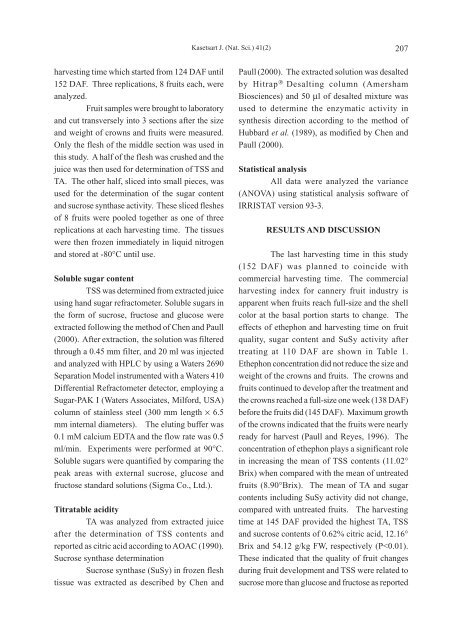April - June 2007 - Kasetsart University
April - June 2007 - Kasetsart University
April - June 2007 - Kasetsart University
Create successful ePaper yourself
Turn your PDF publications into a flip-book with our unique Google optimized e-Paper software.
harvesting time which started from 124 DAF until<br />
152 DAF. Three replications, 8 fruits each, were<br />
analyzed.<br />
Fruit samples were brought to laboratory<br />
and cut transversely into 3 sections after the size<br />
and weight of crowns and fruits were measured.<br />
Only the flesh of the middle section was used in<br />
this study. A half of the flesh was crushed and the<br />
juice was then used for determination of TSS and<br />
TA. The other half, sliced into small pieces, was<br />
used for the determination of the sugar content<br />
and sucrose synthase activity. These sliced fleshes<br />
of 8 fruits were pooled together as one of three<br />
replications at each harvesting time. The tissues<br />
were then frozen immediately in liquid nitrogen<br />
and stored at -80°C until use.<br />
Soluble sugar content<br />
TSS was determined from extracted juice<br />
using hand sugar refractometer. Soluble sugars in<br />
the form of sucrose, fructose and glucose were<br />
extracted following the method of Chen and Paull<br />
(2000). After extraction, the solution was filtered<br />
through a 0.45 mm filter, and 20 ml was injected<br />
and analyzed with HPLC by using a Waters 2690<br />
Separation Model instrumented with a Waters 410<br />
Differential Refractometer detector, employing a<br />
Sugar-PAK I (Waters Associates, Milford, USA)<br />
column of stainless steel (300 mm length × 6.5<br />
mm internal diameters). The eluting buffer was<br />
0.1 mM calcium EDTA and the flow rate was 0.5<br />
ml/min. Experiments were performed at 90°C.<br />
Soluble sugars were quantified by comparing the<br />
peak areas with external sucrose, glucose and<br />
fructose standard solutions (Sigma Co., Ltd.).<br />
Titratable acidity<br />
TA was analyzed from extracted juice<br />
after the determination of TSS contents and<br />
reported as citric acid according to AOAC (1990).<br />
Sucrose synthase determination<br />
Sucrose synthase (SuSy) in frozen flesh<br />
tissue was extracted as described by Chen and<br />
<strong>Kasetsart</strong> J. (Nat. Sci.) 41(2) 207<br />
Paull (2000). The extracted solution was desalted<br />
by Hitrap ® Desalting column (Amersham<br />
Biosciences) and 50 µl of desalted mixture was<br />
used to determine the enzymatic activity in<br />
synthesis direction according to the method of<br />
Hubbard et al. (1989), as modified by Chen and<br />
Paull (2000).<br />
Statistical analysis<br />
All data were analyzed the variance<br />
(ANOVA) using statistical analysis software of<br />
IRRISTAT version 93-3.<br />
RESULTS AND DISCUSSION<br />
The last harvesting time in this study<br />
(152 DAF) was planned to coincide with<br />
commercial harvesting time. The commercial<br />
harvesting index for cannery fruit industry is<br />
apparent when fruits reach full-size and the shell<br />
color at the basal portion starts to change. The<br />
effects of ethephon and harvesting time on fruit<br />
quality, sugar content and SuSy activity after<br />
treating at 110 DAF are shown in Table 1.<br />
Ethephon concentration did not reduce the size and<br />
weight of the crowns and fruits. The crowns and<br />
fruits continued to develop after the treatment and<br />
the crowns reached a full-size one week (138 DAF)<br />
before the fruits did (145 DAF). Maximum growth<br />
of the crowns indicated that the fruits were nearly<br />
ready for harvest (Paull and Reyes, 1996). The<br />
concentration of ethephon plays a significant role<br />
in increasing the mean of TSS contents (11.02°<br />
Brix) when compared with the mean of untreated<br />
fruits (8.90°Brix). The mean of TA and sugar<br />
contents including SuSy activity did not change,<br />
compared with untreated fruits. The harvesting<br />
time at 145 DAF provided the highest TA, TSS<br />
and sucrose contents of 0.62% citric acid, 12.16°<br />
Brix and 54.12 g/kg FW, respectively (P
















